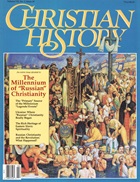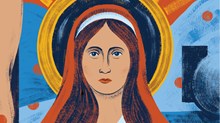General World History
Before 1000
800 Charlemagne is crowned Holy Roman Emperor
935 Wang Chien establishes central monarchy in China
954–55 Norman invasions of France
963–1025 Basil II is Byzantine emperor
981 Eric the Red visits Greenland
988 Vikings attack England
1000
1000 Leif Ericsson reaches America
1054 The Great Separation between Eastern and Western Churches takes place, and largely remains to this day
1066 The Normans conquer England
1071 Byzantine Empire is defeated by Turks at Manzikert
1096–99 First Crusade: to Jerusalem
1100
1100–1135 The first of the Henrys rules in England
1113–1115 Bernard joins the Christian Order, becomes first abbot of Clairvaux
1170 Thomas Becket is murdered
1182–1226 St. Francis of Assisi lives
1187 Saladin captures Jerusalem
1200
1200 Islam begins to replace Indian religions
1215 King John signs Magna Carta
1228-29 Sixth Crusade: Jerusalem regained
1244–1917 Jerusalem in Muslim hands
1260–94 Kublai Khan is emperor of China
1270 Eighth Crusade: to Tunis
1271–95 Marco Polo journeys to China
1273 Rise of Hapsburg family begins
1274 Thomas Aquinas dies
1275 The earliest recorded human dissection takes place
1280–1368 Yuan Dynasty rules China
1300
1305–76 Popes reside at Avignon
1327 Aztecs establish Mexico City
1328–1384 John Wycliffe lives
1348–1453 Hundred Years’ War
1348–50 Black Death ravages Europe
1368–1644 Ming Dynasty in China
1378–1417 The Great schism divides the papacy
1400
1415 Jan Hus is martyred
1420–33 Hussite Wars
1431 Joan of Arc burned
1479–1516 Ferdinand and Isabella rule in Spain
1485–1509 Henry VII, the first Tudor king of
1492–1504 Christopher Columbus discovers America, recrosses Atlantic four times
1490 The first orphanages are established in Italy and Holland
1500
1500 In Europe, the end of the Early and beginning of the High Renaissance
1522 Martin Luther finished translating the New Testament into German
1525 William Tyndale’s translation of the New Testament into English is printed at Wurms
1555 Michelangelo sculpts the Pieta, and tobacco is brought to America for the first time
1577 Francis Drake embarks on voyage around the world via Cape Horn
1600
1700
1800
1861-65 U.S. Civil War
1900
1914–18 World War I
1940–45 World War II
1955 Six of the United States officially recognize the Eastern Orthodox Church as a major faith, and several other states soon follow suit
1961 The “Reform Baptists” separate frm the AUCECB to form the “underground” Council of Evangelical Baptist Churches (curches unregistered with the government and thus illegal); many of them are imprisoned and martyred
1965–75 The Vietnam War
1973–75 The Watergate break-ins, indictments, and convictions
1978 U.S. and the People’s Republic of China establish full diplomatic relations
USSR History
Before 1000
c. 50–60 St. Andrew allegedly does mission work in Ukraine and, standing on the future site of Kiev, predicts that a great Christian city will one day exist there
860–65 With Sts. Cyril and Methodius, Christian missions to the Slavic nations begin in earnest; Cyril establishes Cyrillic alphabet that is still used by Eastern Slavs today
c. 864 Under the auspices of Rus’ Prince Askold and Patriarch Photius, the first baptism in Rus’-Ukraine
869 Eighth Ecumenical Council (in Constantinople)
955 Princess Olga, the queen of Kievan Rus’, is baptized at Constantinople
988–991 Mass baptism takes places at Kiev, Grand Prince Vladimir makes Orthodox Christianity the national religion of Rus’—which it remained until 1917
1000
1019 Yaroslav receives a metropolitan appointed by the Patriarch of Constantinople; this Rus’-Byzantium link continues for nearly 400 years
1025 The beautiful St. Sophia Cathedral is constructed in Kiev
1037 The Russian Orthodox Church comes under the jurisdiction of the Patriarch of Constantinople
1100
1113 The Church of St. Nicholas, one of the first “onion-domed churches,” is built at Novgorod
1200
1204 Eastern Christendom’s center, Constantinople, falls to Western Christendom’s Crusaders
1206–26 Temujin is proclaimed Gengis Khan, rules the Mongols
1220-21 Mongols invade India
1237–40 Mongols invade and destroy Kiev
1250 Hats come into fashion, and goose quills are used for writing
1261 Easterners retake Constantinople
1300
1325 The metropolitan of the Russian Orthodox Church is transferred to Moscow
1326 Moscow becomes capital of Russia, and official center of Russian Orthodox Church
1363 Timur the Lame (Tamerlaine) begins his conquest of Asia
1392 Sergius of Radonezh, the patron saint of Russia, dies
1396 Stephen, a Russian Orthodox bishop and famous missionary, dies
1400
1431–49 The Mongols’ domination of Russia comes to an end
1448 See of Moscow is raised to independent status
1450 Moscow emerges as “The Third Rome,” claiming to have succeeded Rome and Constantinople as the center of the Orthodox Church; Russian Orthodoxy remains virtually untouched by the Renaissance and Reformation
1500
1551 The historic Council of Moscow indicates the declining influence of the patriarchate of Constantinople and the rising influence of Moscow
1589–1605 In Moscow, Iov serves as the first patriarch of the new Russian Orthodox Patriarchate
1596 The Orthodox in Poland unite with Rome, forming what is known as the Uniate Church
1600
1629 Cyril Lucano, the patriarch of Constantinople, makes a Calvinist confession of faith
1642–58 Patriarch Nikon tries to reform the Russian Orthodox Church; a schism results
1685 Moscow Theological Academy is founded
1690–1700 Patriarch Adrian is Russian Orthodoxy’s last patriarch until 20th century
1700
1721 Peter the Great abolishes the Moscow Patriarchate, establishes the Holy Synod as a state institution to carry out church reforms
1783 Potemkin captures Crimea for Russia
1794 Russian Orthodox missionaries begin work in Alaska with fur traders and Indians
1800
1809 St. Petersburg Theological Academy is founded
1848 Karl Marx’s Communist Manifesto
1856–1876 Translation of the entire Bible into vernacular Russian
1867 A German Baptist from Lithuania administers the first Baptist baptism in Russia
1867 Russia sells Alaska to the U.S.
1869 The first Russian Baptist Church is established
1870 Bishop Innocent, former missionary to Alaska, founds the Orthodox Missionary Society
1880 Russian Orthodox leaders begin a persecution of all non-Orthodox sects and churches
1884 First Congress of Russian Baptists
1891 Russian Orthodox leaders intensify their persecution of the non-Orthodox, making it difficult for them to find employment or living quarters, and taking their children to indoctrinate them in the Orthodox faith; non-Orthodox are tried in Orthodox courts, not civil ones
1894 The Russian Orthodox Church forbids Baptists to assemble
1900
1904–07 Russo-Japanese War
1917 The Russian Revolution; Moscow Patriarchate is re-established
1918–28 Lenin separates church and state and proclaims religious freedom; the Baptists begin a pastoral school in Moscow, and a publishing house; Russian Baptists increase to about two million
1919 The American Ukrainian Orthodox Church is organized
1922 USSR is formed
1929–1939 Stalin’s “Age of Terror”; most Russian Christians suffer greatly under this state-sponsored tyranny; the worst years are ’34–38
1943 Desiring to rally the Russian people in the face of Hitler [Hitler ] ’s armies, Stalin re-establishes the Russian Orthodox Church
1944 Soviet government orgainzes the All-Union Council of Evangelical Christians-Baptists; but Soviet control of the AUCECB makes numerous Christians oppose it
1959–64 Khruschev oversees a great persecution of Christians, though not so murderous as Stalin’s
1960 The USSR makes its restrictive statutes upon the AUCECB ever more stringent
1961 Churches in the USSR join World Council of Churches
1974–75 For his writings against Soviet repression, Alexander Solzhenitsyn is exiled, writes The Gulag Archipelago, Vols. One and Two
1986 Gorbachev initiates policy of glasnost, or "openness," and Soviets' freedom of religions increases somewhat
1988 Millenial anniversary of Christianity in the USSR
Kievan Rulers
978–1015 Vladimir I rules Keivan Rus’
1019–54 Yaroslav “the Wise” rules Rus’
1113–1125 Vladimir Monomach rules in Rus’
1125–1140 Other members of Vladimir’s dynasty continue to rule a constantly sub-dividing Rus’
1325–1341 Ivan I rules in Moscow
1359–1389 Dmitri Donskoy rules in Moscow
1425–1462 Vasili II rules in Moscow
1462–1505 Ivan III “the Great” rules Russia
1547–1584 Ivan IV “the Terrible” rules Russia
1645–1676 Alexei rules Russia
1721–1725 Peter “the Great” is emperor of Russia
1762–96 Catherine II is empress of Russia
1801–25 Alexander I is tsar of Russia
1894–1917 Nicholas II rules Russia
1920–24 Lenin rules USSR
1924–53 Josef Stalin
1953–64 Nikita Khruschev
1964–80 Leonid Brezhnev
1980–85 Kosygin and Andropov
1985-?? Mikhail Gorbachev
Copyright © 1988 by the author or Christianity Today/Christian History magazine.
Click here for reprint information on Christian History.

Support Our Work
Subscribe to CT for less than $4.25/month





























